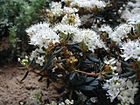Note: This is a project under development. The articles on this wiki are just being initiated and broadly incomplete. You can Help creating new pages.
Rhododendron tomentosum - Wild rosemary
Rhododendron tomentosum (syn. Ledum palustre), commonly known as marsh Labrador tea, northern Labrador tea or wild rosemary, is a flowering plant in the subsection Ledum of the large genus Rhododendron in the family Ericaceae.
Uses
Parts Used
Chemical Composition
The main constituents of the oils were p-cymene (44.02%), linalool (20.5%), γ-terpinene (16.62%), thymol (1.81%), β-pinene (3.61%), α-pinene (2.83%) and eucalyptol (2.64%). The oil consisted of monoterpenic hydrocarbons, oxygenated monoterpenes and sesquiterpene hydrocarbons[1]
Common names
| Language | Common name |
|---|---|
| Kannada | |
| Hindi | |
| Malayalam | |
| Tamil | |
| Telugu | |
| Marathi | NA |
| Gujarathi | NA |
| Punjabi | NA |
| Kashmiri | NA |
| Sanskrit | |
| English | Agrimony |
Properties
Reference: Dravya - Substance, Rasa - Taste, Guna - Qualities, Veerya - Potency, Vipaka - Post-digesion effect, Karma - Pharmacological activity, Prabhava - Therepeutics.
Dravya
Rasa
Tikta (Bitter), Kashaya (Astringent)
Guna
Laghu (Light), Ruksha (Dry), Tikshna (Sharp)
Veerya
Ushna (Hot)
Vipaka
Katu (Pungent)
Karma
Kapha, Vata
Prabhava
Habit
Identification
Leaf
| Kind | Shape | Feature |
|---|---|---|
| Simple | Needle-shaped | The small, needle-shaped leaves are another adaptation that limits water loss |
Flower
| Type | Size | Color and composition | Stamen | More information |
|---|---|---|---|---|
| Unisexual | 2-4cm long | white | 8 | the flowers are a composition of 2-3 showy |
Fruit
| Type | Size | Mass | Appearance | Seeds | More information |
|---|---|---|---|---|---|
| 7–10 mm | clearly grooved lengthwise, Lowest hooked hairs aligned towards crown | many | {{{6}}} |
Other features
List of Ayurvedic medicine in which the herb is used
Where to get the saplings
Mode of Propagation
How to plant/cultivate
Requires a lime-free loam or peaty soil[1, 11]. Prefers a moist humus-rich acid soil in shade or semi-shade[[3]
Commonly seen growing in areas
Photo Gallery
References
External Links
- Pages with broken file links
- Ayurvedic Herbs known to be helpful to treat Asthma
- Ayurvedic Herbs known to be helpful to treat Cough
- Ayurvedic Herbs known to be helpful to treat Cold
- Ayurvedic Herbs known to be helpful to treat Stomach aches
- Ayurvedic Herbs known to be helpful to treat Kidney ailments
- Ayurvedic Herbs known to be helpful to treat Burns
- Ayurvedic Herbs known to be helpful to treat Ulcers
- Ayurvedic Herbs known to be helpful to treat Stings
- Ayurvedic Herbs known to be helpful to treat Infections
- Herbs with Leaves used in medicine
- Herbs with common name in English
- Habit - Herb
- Index of Plants which can be propagated by Seeds
- Index of Plants which can be propagated by Cuttings
- Herbs that are commonly seen in the region of Tall grasslands
- Herbs that are commonly seen in the region of Bridge of Allan in Sterling and Perth
- Herbs
- Ayurvedic herbs that don't have seed photos
- Ericaceae






